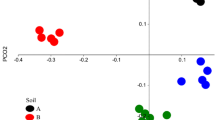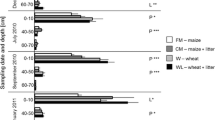Abstract
Under certain soil conditions, e.g. hardsetting clay B-horizons of South-Eastern Australia, wheat plants do not perform as well as would be expected given measurements of bulk soil attributes. In such soils, measurement indicates that a large proportion (80%) of roots are preferentially located in the soil within 1 mm of macropores. This paper addresses the question of whether there are biological and soil chemical effects concomitant with this observed spatial relationship. The properties of soil manually dissected from the 1–3 mm wide region surrounding macropores, the macropore sheath, were compared to those that are measured in a conventional manner on the bulk soil. Field specimens of two different soil materials were dissected to examine biological differentiation. To ascertain whether the macropore sheath soil differs from rhizosphere soil, wheat was grown in structured and repacked cores under laboratory conditions. The macropore sheath soil contained more microbial biomass per unit mass than both the bulk soil and the rhizosphere. The bacterial population in the macropore sheath was able to utilise a wider range of carbon substrates and to a greater extent than the bacterial population in the corresponding bulk soil. These differences between the macropore sheath and bulk soil were almost non-existent in the repacked cores. Evidence for larger numbers of propagules of the broad host range fungus Pythium in the macropore sheath soil were also obtained.
Similar content being viewed by others
References
Ali-Shtayeh M S, Len L-H C and Dick M W 1986An improved method and medium for quantitative estimates of Pythium species from soil. Trans. Brit. Mycol. Soc. 86, 39–47.
Badalucco L, Kuikman P J and Nannipieri P 1996Protease and deaminase activities in wheat rhizosphere and their relation to bacterial and protozoan populations. Biol. Fertil. Soils 23, 99–104.
Bullock P, Fedoroff N, Jongerius A, Stoops G and Tursina T 1985 Handbook for soil thin section description. Waine Research Publications, Wolverhampton. 152 p.
Cavigelli M A, Robertson G P and Klug M J 1995Fatty acid methyl ester (FAME) profiles as measures of soil microbial community structure. Plant Soil 170, 99–113.
Colwell J D 1965An automated procedure for the determination of phosphorus in sodium hydrogen carbonate extracts of soils. Chem. Ind. 22, 893–895.
Dormaar J F 1988Effect of plant roots on chemical and biochemical properties of surrounding discrete soil zones. Can. J. Soil Sc. 68, 233–242.
Frostegard A, Baath E and Tunlid A 1993Shifts in the structure of soil microbial communities in limed forests as revealed by phospholipid fatty acid analysis. Soil Biol. Biochem. 25, 723–730.
Frostegaard A and Baath E 1996The use of phospholipid fatty acid analysis to estimate bacterial and fungal biomass in soil. Biol. Fertil. Soils 22, 59–65.
Gardner W R 1960Dynamics aspects of water availability to plants. Soil Sc. 89, 63–73.
Gobran G R and Clegg S 1996A conceptual model for nutrient availability in the mineral soil-root system. Can. J. Soil Sc. 76, 125–131.
Kirkegaard J A, Gardner P A, Angus J F and Koetz E 1994Effect of Brassica break crops on the growth and yield of wheat. Aust. J. Agric. Res. 45, 529–45.
McCully M E 1995How do real roots work? Plant Physiol. 109, 1–6.
McKenzie R H, Dormaar J F, Schaalje G B and Stewart J W B 1995 Chemical and biological changes in the rhizosphere of wheat and canola. Can. J. Soil Sci. 75, 439–447.
Marschner H, Römheld V, Horst W J and Martin P 1986Rootinduced changes in the rhizosphere: Importance for mineral nutrition of plants. Z. Pflanzenernähr. Bodenk. 149, 441–456.
Marschner H, Römheld V and Cakmak I 1987Root induced changes in nutrient availability in the rhizosphere. J. Plant Nutr. 10, 1175–1184.
Moran C J, Stewart J B and Kirby J M 1998Simulation of root extraction of moisture from unsaturated structured soil. Proc. of the 16th World Congress of Soil Science, Montpellier, Aug. 20-26, 1998, Cirad.
Olsson P A, Baath E, Jakobsen I and Soderstrom B 1995The use of phospholipid and neutral lipid fatty acids to estimate biomass of arbuscular mycorrhizal fungi in soil. Mycol. Res. 99, 623–629.
Passioura J B 1985Roots and water economy of wheat. In Wheat growth and modelling. Eds Day W and Atkin R K. pp 185–198. Plenum, New-York.
Passioura J B 1991Soil structure and plant growth. Aust. J Soil Res. 29, 717–728.
Reuter D J, Dyson C B, Elliott D E, Lewis D C and Rudd C L 1995An appraisal of soil phosphorus testing data for crops and pastures in South Australia. Aust. J. Experim. Agric. 35, 979–995.
Richardson A E 1994Soil microorganisms and phosphorus availability. In Soil biota. Management in sustainable farming systems. Eds C E Pankhurts, B M Doube, V V S R Gupta and P R Grace. pp 50–62. CSIRO, East Melbourne.
Robinson D 1994Tansley Review No. 73 The responses of plants to non-uniform supplies of nutrients. New Phytol. 127, 635–674.
Soil Survey Staff 1998Keys to soil taxonomy. U.S.D.A., Natural Resources Conservation Service.
Stewart J B 1997The spatial distribution of plant roots and their interaction with soil structure. Ph.D. Thesis, The University of Sydney, Australia.
Stewart J B, Moran C J and Wood J T 1996Quantifying the spatial relationship between plant roots and soil macropores. In Soil Science – Raising the Profile: Volume 2 Oral Papers. Australian and New Zealand National Soils Conference, Melbourne, 1–4 July 1996, pp 269–270.
Sleeman J R 1979The soils of the Ginninderra experiment station, A.C.T. Division of Soils Divisional Report No. 41. CSIRO.
Volkmar K M 1996Effects of biopores on the growth and N-uptake of wheat at three levels of soil moisture. Can. J. Soil Sci. 76, 453–458.
Watt M, McCully M E and Canny M J 1994Formation and stabilization of rhizosheaths in Zea mays L. Effect of soil water content. Plant Physiol. 106, 179–186.
Zak D R, Ringelberg D B, Randlett D L, White D C and Curtis P S 1996Soil microbial communities beneath populus grandidentat grown under elevated atmospheric CO2. Ecol. Appl. 6, 257–262.
Author information
Authors and Affiliations
Rights and permissions
About this article
Cite this article
Pierret, A., Moran, C. & Pankhurst, C. Differentiation of soil properties related to the spatial association of wheat roots and soil macropores. Plant and Soil 211, 51–58 (1999). https://doi.org/10.1023/A:1004490800536
Issue Date:
DOI: https://doi.org/10.1023/A:1004490800536




